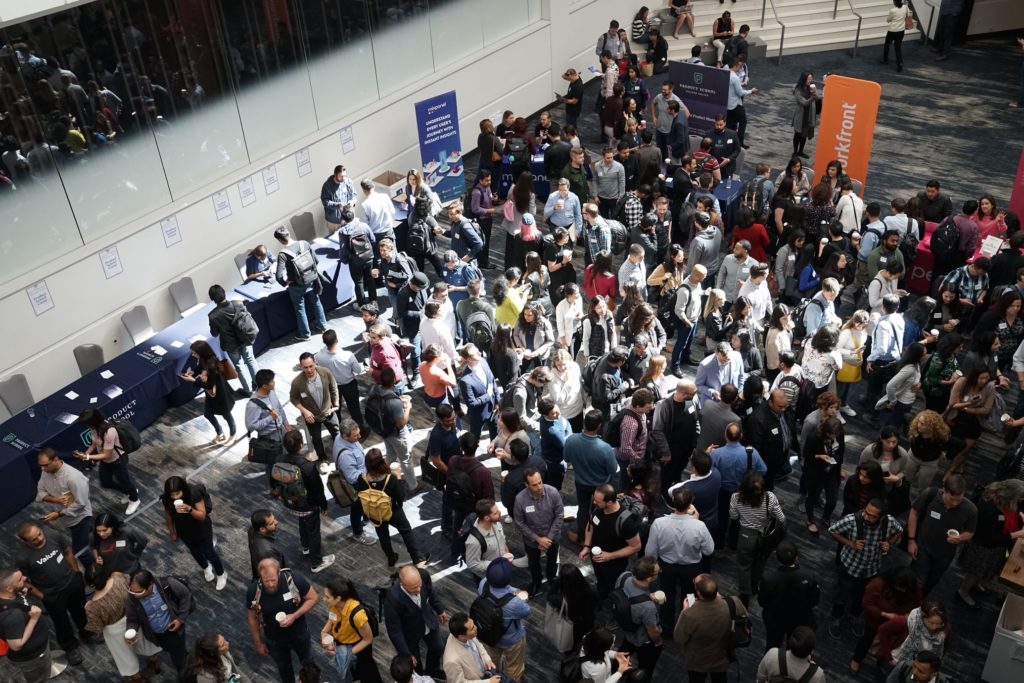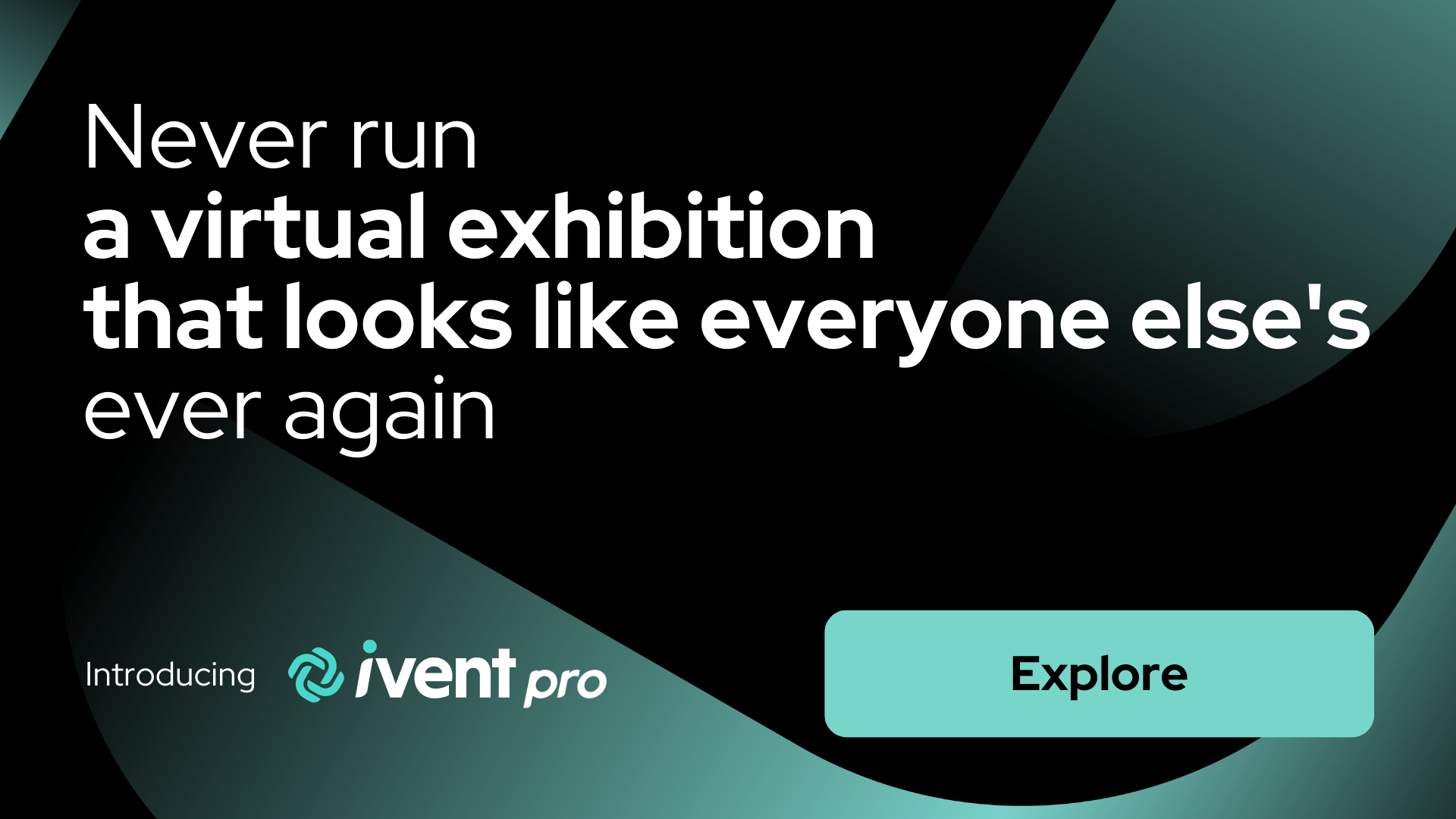Different Types of Virtual Exhibitions (With Examples!)

If there’s one thing you need to know about virtual exhibitions it’s that anything and everything is possible.
Want to take your art exhibitions online for visitors to attend? Go for it. Work in the healthcare industry and want to appeal to investors overseas? Well, turning to virtual provides an excellent pathway to do just that too!
You’ve more than likely already come across the virtual exhibitions term from reading some of the pages here on the iVent site. For example, you’ve probably read a little on trade shows, which are technically exhibitions too, only they tend to be a lot more sales focused.
In case you haven’t guessed, the only limits to virtual exhibitions lie in the imagination of the organisers, as proven by the countless online exhibition examples we’ll get to in just a few moments.
There are numerous benefits to running an exhibition in a virtual setting, which we’ll also cover as we go on. Although, many shouldn’t require too much explanation.
For now, let’s look at a quick definition to break down what we mean exactly when we say ‘virtual exhibitions.’
What are Virtual Exhibitions?
It’s a pretty self-explanatory term when you think about it, still, it’s worth clarifying as the term is so often used interchangeably with other types of virtual events.
A virtual exhibition is essentially the same as those you’d find in the real world in that it involves displaying physical media in an open format that allows people to engage with the creator or brand directly.
With virtual exhibitions there’s a digital element at play, allowing organisers and institutions to reach audiences in a completely new light through the power of technology. Reaching out to people in ways that weren’t possible before.
One of the major benefits to bringing an exhibition online is that it increases attendance rates by a massive margin. By running a virtual technology fair, for example, exhibitors have the ability to invite delegates from around the world to attend!
What’s more, virtual exhibitions attract more exhibitors too, in that these events are next to impossible to ignore from a popularity standpoint.
It’s all very inclusive, and is only possible with that digital element. Furthermore, attendees aren’t limited by how they participate in these events. Live chat, live video, and audio make it feel like you’re actually there!
And that’s without mentioning the virtual booths that organisers can currently have created for them. Those that act like your traditional in-person booth, only with a twist. Very handy to have if you’re a brand looking to raise awareness and interact with customers at virtual trade shows!
The number of virtual exhibitions out there grows by the year. This includes hybrid virtual exhibitions where the line between live and recorded events begins to intertwine.
What about Hybrid Virtual Exhibitions?
Hybrid virtual exhibitions are unique in that they have that virtual element, but it’s balanced with a live factor.
So, an example of this would be a virtual art exhibition where an artist showcases his or her work in front of people that are actually in the room with them, only this experience is recorded and streamed for a remote audience who take part externally.
This is just one example of a hybrid virtual exhibition but there are various ways to do it depending on the type of event you’re putting together.
Again, how you do it comes down to the limits of your own imagination – or the limits of the virtual event platform.
Virtual Exhibition Examples
Okay, so you should have a pretty good idea of what virtual exhibitions are at this point – plus, a few of the benefits that come with this type of event format (worldwide appeal, for example).
It’s time now that we looked at some legitimate examples of virtual exhibitions, as promised. Reading on should inspire you to form your own virtual exhibition ideas, or at the very least, clue you in on some of the best exhibitions out there that are trying to do something a little different.
We’ll include real examples under each type to give you a better idea how hosts have done it in the past, and to inspire you in your own efforts.
To start, let’s look at technology fairs, arguably the first type of event people think of when it comes to exhibitions.
Technology Fair/Trade Shows
Trade shows are almost always linked to virtual exhibitions in that they involve promoting products or services to those in attendance.
They might not have the word ‘exhibitions’ in the name, but they are pretty similar if we’re talking definitions. That being said, trade shows tend to be a lot more commercialised compared to, say, a virtual art exhibition, which explains why these events go by their own term.
There are trade shows for everything these days, be it electric boats, unique-looking furniture, light food snacks etc, etc. Most of these events now have a virtual upside in that they run with hybrid rules, having both in person appeal and remote access for others to participate.
A technology fair is another way to refer to trade shows. However, these events are a lot more streamlined and focused on tech exclusively hence the name!
Technology Fair Example: Consumer Electronics Show
The annual Consumer Electronics Show (CES) opted for a virtual approach in 2021. Exhibition organisers chose to go for an all-digital event to combat the rising number of Covid cases in America. The result was an event watched by millions.
While the next CES will go back to its original format, bringing tech experts together physically, event organisers have stated that they want there to be a digital aspect moving forwards.
The Consumer Technology Association who puts together these events, announced that the next CES event held in Las Vegas will run on a cloud-based digital platform for experiencing the show from afar. Attendees will be able to network with exhibitors externally using this platform.
Here’s what Jean Foster, CTA’s senior vice president of marketing, had to say: “We want to make a strong digital component of the show where the audience can participate and engage digitally, not just to view the conference programs and the keynotes, but to really engage with the exhibitors.”
Healthcare Exhibitions
Healthcare exhibitions are attended by hundreds upon thousands of professionals and delegates annually. These events are used to showcase new products, feature the latest research and more (depending on the healthcare exhibition you attend).
You could group these events in with conferences, although there are a number of healthcare exhibitions that do fall into the exhibition category in some way or another. These types of events are overarching in that way.
The ability to interact with healthcare professionals from here, there and everywhere is ideal, as most in attendance are extremely busy, and therefore lack the time to be there in person.
Healthcare Exhibitions Example: Future Health Innovations
One that instantly comes to mind is the Future Health Innovations event. This hybrid event allows delegates to network and learn in person and online.
It should come as no surprise that an event all about future advances in healthcare is taking such a forward-thinking approach to spreading information and establishing connections from around the world and back!
The event runs on an event platform made by the organisers, and is said to enable an increased ROI and profitable encounters all round. The platform works in a very similar way to our own in that it adapts to what it’s needed for.
For those not in the know, we’re iVent, specialists in virtual exhibitions and events. Our bespoke platform is unique in that it can be built around your wants and needs. The examples shown here are just a glimmer of what is possible when you partner with us.
Student Exhibitions
We know that the education sector utilises virtual events for open days, but what about exhibitions? You know, events where it’s all about pulling focus to the work completed by students.
Colleges and universities are home to many talented students, which explains why virtual spaces are currently used to show off their work to parents, friends, and anyone remotely interested.
Virtual exhibitions for architecture students, in particular, have showcased a variety of unique buildings within a 3D environment, allowing spectators to map the areas they’ve built with incredible detail.
You might think that this is exclusive to those who attend traditional exhibitions in person, but there are virtual platforms out there capable of running these previews for people to access externally!
We know it’s possible because our platform is optimised for off the wall ideas just like that – or any idea that involves getting you in front of the audiences that matter.
Student Exhibitions Example: UIC School of Architecture
In Chicago at the University of Illinois, students showcased their work in a complete virtual environment, one that visitors could navigate through a whiteboard app, zooming in on images and text.
This wasn’t the first time the institution had dabbled with virtual exhibition spaces to display the work of students. By offering the work of students in this format, more eyes were cast on the students themselves.
Virtual Art Exhibitions
Arts and entertainment suffered a significant blow due to the pandemic. Still, this didn’t stop galleries and independent artists from displaying their works in other ways.
Enter virtual art exhibitions – the chance to showcase collections without asking attendees to leave the comfort of their own home. This is a trend that has continued beyond the pandemic with galleries around the world showcasing art in a complete virtual setting.
How these virtual events are put together does vary a fair amount. Some virtual art exhibitions are static in that they consist of a single platform and various static images. Others offer a full 180 degree experience through video, which simulates the feeling of actually being there in person.
There are also virtual exhibitions where artists launch their projects in a complete digital space. Some even take it a step further and incorporate the digital element into the pieces themselves as a form of commentary.
Virtual Art Exhibitions Example: Decentraland
Remember when we said that some incorporate the digital element within their art? Yeah, Decentraland by Philip Colbert is essentially that.
Colbert’s goal was to test the limits of digital possibilities, so he created an entire virtual space for attendees to navigate on their own. By entering the city he created (LOBSTEROPOLIS CITY), attendees were invited to create their own avatars and even create their own piece of the universe.
This project is one of many examples of virtual art exhibitions where the artist has really highlighted what is currently possible with digital platforms.
Different Types of Virtual Exhibitions (With Examples!)
As you can see, virtual exhibitions cover a wide range of events, the same applies to hybrid virtual exhibitions that blend the real-world in with the digital.
And while a virtual art exhibition does top the list in terms of the most interesting from a creativity standpoint, there’s no denying the appeal of student exhibitions, technology fairs/trade shows and healthcare exhibitions!
We hope that by providing you with examples to the various virtual exhibitions covered, that you now have a good idea of what they are exactly, and how they might differ from online training events or conferences.
Just keep in mind that you’re going to need a robust virtual event platform in order to run these events. Settling for the first you find is likely to mess with the overall quality and consistency of your exhibition – or any future exhibitions.
You should be looking for something adaptable – one that communicates your own signature style and branding to make for an authentic experience.
One of the best things about working with an adaptable virtual platform is simply that: it’s adaptable. And the iVent platform is incredibly flexible when it comes to fitting the needs of your next virtual exhibition.
Have a virtual art exhibition you’d like to get off the ground? What about a technology fair, is that more your area of expertise? Whichever it is, we want to hear it. Simply get in touch with a member of our team and let’s get started!
Virtual Exhibitions FAQs
What is a virtual exhibition exactly?
Virtual exhibitions are those held in a complete digital space, taking what you’d typically associate with physical exhibitions (like visiting an art gallery, for example) and giving access to people everywhere.
How does a virtual exhibition hall work?
A virtual exhibition hall is essentially that: a space where you can show off your booth and products in a complete virtual setting. How the hall looks and how exhibition attendees can interact with this space is completely up to the organisers and the platform they choose.
Is a technology fair different from a trade show?
The two are often used interchangeably with one another, meaning it’s up to the organisers to decide on which type of event it is. Still, a technology fair tends to be about, well, technology, and trade shows tend to be a lot more expansive in terms of what’s on show.
What are the benefits of running a virtual exhibition?
Outside of being a lot easier to access from an attendee point of view, running a virtual exhibition has countless benefits. For starters, exhibitors don’t need to spend money on more assets with it being in a digital space. Also, exhibitors can measure ROI in real-time through these platforms!





 Ros Oxley
Ros Oxley

